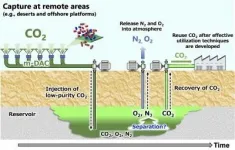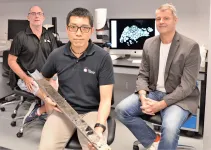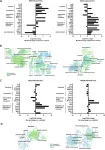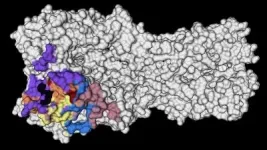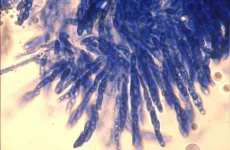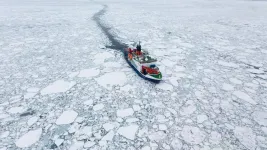A new water treatment technology could also help Mars explorers
A catalyst that destroys perchlorate in water could clean Martian soil
2021-06-04
(Press-News.org) A team led by UC Riverside engineers has developed a catalyst to remove a dangerous chemical from water on Earth that could also make Martian soil safer for agriculture and help produce oxygen for human Mars explorers.
Perchlorate, a negative ion consisting of one chlorine atom bonded to four oxygen atoms, occurs naturally in some soils on Earth, and is especially abundant in Martian soil. As a powerful oxidizer, perchlorate is also manufactured and used in solid rocket fuel, fireworks, munitions, airbag initiators for vehicles, matches and signal flares. It is a byproduct in some disinfectants and herbicides.
Because of its ubiquity in both soil and industrial goods, perchlorate is a common water contaminant that causes certain thyroid disorders. Perchlorate bioaccumulates in plant tissues and a large amount of perchlorate found in Martian soil could make food grown there unsafe to eat, limiting the potential for human settlements on Mars. Perchlorate in Martian dust could also be hazardous to explorers. Current methods of removing perchlorate from water require either harsh conditions or a multistep enzymatic process to lower the oxidation state of the chlorine element into the harmless chloride ion.
Doctoral student Changxu Ren and Jinyong Liu, an assistant professor of chemical and environmental engineering at UC Riverside's Marlan and Rosemary Bourns College of Engineering, took inspiration from nature to reduce perchlorate in water at ambient pressure and temperature in one simple step.
Ren and Liu noted anaerobic microbes use molybdenum in their enzymes to reduce perchlorate and harvest energy in oxygen-starved environments.
"Previous efforts in constructing a chemical molybdenum catalyst for perchlorate reduction have not been successful," Liu said. "Many other metal catalysts either require harsh conditions or are not compatible with water."
The researchers tried to emulate the complicated microbial perchlorate reduction process with a simplified approach. They found by simply mixing a common fertilizer called sodium molybdate, a common organic ligand called bipyridine to bind the molybdenum, and a common hydrogen-activating catalyst called palladium on carbon, they produced a powerful catalyst that quickly and efficiently broke down the perchlorate in water using hydrogen gas at room temperature with no combustion involved.
"This catalyst is much more active than any other chemical catalyst reported to date and reduces more than 99.99% of the perchlorate into chloride regardless of the initial perchlorate concentration," Ren said.
The new catalyst reduces perchlorate in a wide concentration range, from less than 1 milligram per liter to 10 grams per liter. This makes it suitable for use in various scenarios, including remediating contaminated groundwater, treating heavily contaminated wastewater from explosives manufacturing, and making Mars habitable.
"A convenient catalytic reduction system may help harvest oxygen gas from perchlorate washed from the Martian soil when the catalyst is coupled with other processes," Liu said.
INFORMATION:
The paper, "A bioinspired molybdenum catalyst for aqueous perchlorate reduction," was published in the Journal of the American Chemical Society. Ren and Liu were joined in the research by UC Riverside doctoral student Jinyu Gao, undergraduate student Jacob Palmer, and high school student Eric Y. Bi. Peng Yang and Mengqiang Zhu at the University of Wyoming characterized the catalyst with X-ray absorption spectroscopies and Ohio State University's Jiaonan Sun and Yiying Wu performed the electrochemical testing. The research was funded by the National Science Foundation.
ELSE PRESS RELEASES FROM THIS DATE:
2021-06-04
Fukuoka, Japan - The global threat of ongoing climate change has one principal cause: carbon that was buried underground in the form of fossil fuels is being removed and released into the atmosphere in the form of carbon dioxide (CO2). One promising approach to addressing this problem is carbon capture and storage: using technology to take CO2 out of the atmosphere to return it underground.
In a new study published in Greenhouse Gases Science and Technology, researchers from Kyushu University and the National Institute of Advanced Industrial Science and Technology, Japan, investigated geological storage of low-purity CO2 mixed with nitrogen (N2) and oxygen (O2), produced by direct air capture (DAC) using membrane-based technology.
Many current ...
2021-06-04
Climate scientists at the Nanyang Technological University, Singapore (NTU, Singapore) have extended the known record of Singapore's sea-level to almost 10,000 years ago, providing a more robust dataset to aid future predictions of sea-level rise.
One of the main challenges in researching climate change is to reconstruct its history over thousands of years. To have a better sense of the potential causes and effects of future changes, scientists need to learn from and understand the past.
Extracting ancient sediments from a depth of up to 40 m underground at a site at Singapore's Marina South, an international team led by NTU researchers put the samples through rigorous laboratory ...
2021-06-04
Bottom Line: The majority of surveyed Americans had an inadequate understanding of palliative care, and frequency of health care utilization was one determinant of knowledge.
Journal in Which the Study was Published: Cancer Epidemiology, Biomarkers & Prevention, a journal of the American Association for Cancer Research
Author: Motolani Ogunsanya, PhD, an assistant professor at The University of Oklahoma Health Sciences Center
Background: Palliative care aims to improve the quality of life for patients and caretakers by addressing the physical, psychological, and logistical challenges associated with a disease or its treatment. In contrast to hospice, which provides comfort care for patients who have stopped treatment and are near the end of life, palliative care serves as an ...
2021-06-04
Oncotarget published "Characterization of the inflammatory microenvironment and hepatic macrophage subsets in experimental hepatocellular carcinoma models" which reported that HCC typically develops on a background of chronic inflammation and fibrosis with tumor associated macrophages playing an important role in chronic inflammation-induced HCC and progression.
However, the liver harbors unique macrophages, resident liver Kupffer cells and monocyte-derived macrophages, and their contribution to HCC and to the population of TAMs is incompletely known.
Here, the authors characterized the tumor microenvironment and the proportion and transcriptional profile of ...
2021-06-04
A growing number of people use they/them pronouns to signal their gender identity, but for many people, use of "they" to refer to a single individual takes some getting used to.
Results of a recent END ...
2021-06-04
Lauren Dreier was paging through a 19th century book by the German architect Gottfried Semper when she spotted some intriguing patterns inspired by lace. A professional artist and designer who often incorporates technology into her work, Dreier, who is also a doctoral student at the School of Architecture at Princeton University, decided to recreate the printed illustrations in 3D.
She grabbed ribbon-like plastic material she had been experimenting with in her studio, bending and connecting the semi-rigid strips. To Dreier's surprise, the structure she built assumed a bumpy geometry, with four distinct hills and valleys. "I thought it would make a dome, but it was this unusual shape," Dreier said. Curious to know what caused ...
2021-06-04
A new study from the University of Chicago and Scripps Research Institute shows that during the last great pandemic--2009's H1N1 influenza pandemic--people developed strong, effective immune responses to stable, conserved parts of the virus. This suggests a strategy for developing universal flu vaccines that are designed to generate those same responses, instead of targeting parts of the virus that tend to evolve rapidly and require a new vaccine every year.
Influenza is an elusive and frustrating target for vaccines. There are two main types of flu virus that can infect humans, which evolve rapidly from season to season. ...
2021-06-04
Neurological and psychiatric symptoms such as fatigue and depression are common among people with Covid-19 and may be just as likely in people with mild cases, according to a new review study led by a UCL researcher.
By reviewing evidence from 215 studies of Covid-19, the meta-analysis published in the Journal of Neurology, Neurosurgery and Psychiatry reports a wide range of ways that Covid-19 can affect mental health and the brain.
Lead author Dr Jonathan Rogers (UCL Psychiatry and South London and Maudsley NHS Foundation Trust) said: "We had expected that neurological and psychiatric symptoms would be ...
2021-06-04
Researchers have re-animated specimens of a fungus that causes coffee wilt to discover how the disease evolved and how its spread can be prevented.
Coffee Wilt Disease is caused by a fungus that has led to devastating outbreaks since the 1920s in sub-Saharan Africa, and currently affects two of Africa's most popular coffee varieties: Arabica and Robusta.
The new research shows that the fungus likely boosted its ability to infect coffee plants by acquiring genes from a closely related fungus, which causes wilt disease on a wide range of crops, including ...
2021-06-04
Sea ice in the coastal regions of the Arctic may be thinning up to twice as fast as previously thought, according to a new modelling study led by UCL researchers.
Sea ice thickness is inferred by measuring the height of the ice above the water, and this measurement is distorted by snow weighing the ice floe down. Scientists adjust for this using a map of snow depth in the Arctic that is decades out of date and does not account for climate change.
In the new study, published in the journal The Cryosphere, researchers swapped this map for the results of a new computer model designed to estimate snow depth as it varies year to year, and concluded that sea ice in key ...
LAST 30 PRESS RELEASES:
[Press-News.org] A new water treatment technology could also help Mars explorers
A catalyst that destroys perchlorate in water could clean Martian soil
